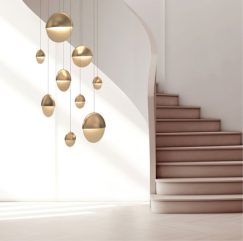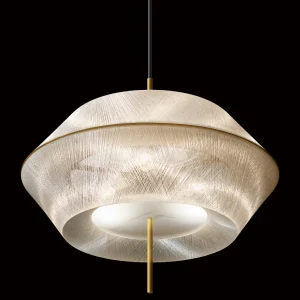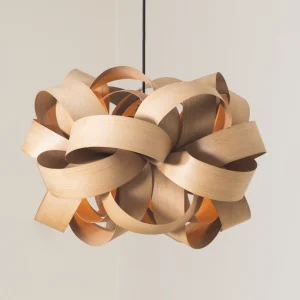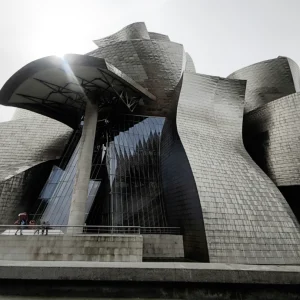
Outside Lumination
FX AWARDS LIGHTING PRODUCT WINNER
SLICE COLLECTION
Company: Republic of II By IV, in collaboration with Viso Lighting
The Slice collection manages to tick a lot of lighting boxes. It also rather elegantly shows, should it need demonstrating, that the worthy and the stylish are not irreconcilable. First, the designers have fully considered and exploited lighting effect. Balancing direct and diffused light, the fixtures feature an aperture on both sides of the disc shape for a dual source of illumination.
They also play with reflectivity, featuring, for instance, a more matt surface finish on the lower half and a more polished finish on the upper half, which overlaps it and from which the light seeps. (The plated or powder-coated finishes can be specified according to the project, as can different colour temperatures.)
The pendants are available in three different pendant sizes and can be grouped in a variety of ways – a symmetrical trio for a reception desk, for example, or a cluster of different sizes at various heights for a stairwell or lobby.
There is a careful attention to detail – no screws or weld marks – to create a seamless appearance. The manufacturing process also has good eco credentials. The fixtures are made with recyclable materials, and there is an emphasis on reuse and minimising waste. Advanced fabrication techniques – applied to metal spinning, precision welding and laser cutting – also enable precise component production to reduce material waste as well as ensure consistency across installations.
There is a focus on selecting eco-friendly materials and suppliers committed to sustainable practices. Throughout the manufacturing process, environmental considerations such as waste management, energy, and water use are carefully monitored.
FX AWARDS LIGHTING DESIGN WINNER ST PATRICK’S CHURCH, NEWPORT, COUNTY MAYO
Lighting design: Dark Source
In the company of some comparatively grand projects, this year’s winner of the FX award for Lighting Design is a modest affair. But St Patrick’s Church, in the small town of Newport in north-west Ireland, is an exemplar of the importance of darkness – not only in terms of the night sky and nocturnal ecosystem, but also in creating an arresting lighting scheme.
The church is the first completed phase of a wider vision, the Newport Dark Sky Masterplan, developed by Dark Source in collaboration with Mayo Dark Skies.
Judging by the ‘before’ images, St Patrick’s was originally lit very poorly, a typically crude floodlighting scheme that did a disservice to the architecture, the environment and any creature within eyeshot.
The local community had a close involvement and wanted the new scheme to be more sustainable, less polluting and aesthetically superior, as well as more engaging and welcoming for both the local community and visitors – all of which had to be achieved on a low budget and with technical constraints.
‘We wanted to eliminate light pollution through the new design and convey the idea that a powerful night-time image can be created through judicious use of light,’ says Kerem Asfuroglu of Dark Source. ‘We wanted to balance the visual, social and environmental objectives for the town with the ultimate aim of protecting dark skies and enhancing the night-time experience for both people and biodiversity.’
 Photos: Georgia Macmillan And Michael Mclaughlin
Photos: Georgia Macmillan And Michael Mclaughlin
It also illustrates, adds Asfuroglu, ‘the effectiveness of small but organised communities when taking environmental action despite the lack of resources’.
The local community fully participated in the design development, from actively taking part in the lighting tests through to installing shields on site. ‘This process fostered both social and environmental sustainability, which are essential for the longevity of any design project,’ says Asfuroglu.
Luminaires were carefully modified and embedded in the architecture to avoid affecting the heritage fabric and to reduce impact on the surrounding ecosystem. Uplighting is only used where the light spill can be contained. Backlighting the windows on the front facade emphasised their verticality and the colourful design of the stained glass, while all other windows relied on passive illumination.
‘The warm-lit windows are designed to evoke an inviting sense of domesticity,’ says Asfuroglu. ‘The old scheme solely focused on emphasising verticality through excessive floodlighting but the new lighting restructured this hierarchy by balancing both the vertical and horizontal experience.’
The church grounds were treated as an extension of the facade illumination to encourage social activity after dark. Heritage-style lanterns were introduced to improve the image and experience of the architecture both day and night.
As part of that engagement, and highly innovative for a small church scheme, a striking exterior gobo projection forms part of the design. Featuring the stained glass window titled The Last Judgement – by Irish artist Harry Clarke and installed in 1931 – it is projected on to the ground outside as if the interior light was spilling from the rear facade windows.
‘It has transformed the church’s night-time role from being an object of interest to a destination worth visiting both for the locals and visitors, allowing people to appreciate the details and interact with the projection,’ says Asfuroglu.
The budgetary and technical constraints meant that existing cabling was used as much as possible. A simplified lighting regime was also created using timers and daylight sensors. The lack of a sophisticated dimming and control system – now de rigueur in grander ecclesiastical schemes – meant a rigorous balancing of all the light layers at the right level of intensity.
The vertical features switch off at midnight while illumination of the periphery of the site (partially in the public realm) allows safe access until dawn. A warm white colour temperature (2200K) was used across the board to minimise the environmental impact while adding to the consistently warm and inviting feel.
The new LED scheme (inclusive of the interior relamping) has cut almost two tonnes of CO2e and resulted in a 40% reduction in light pollution.
‘It challenges the common doctrine that one must fully illuminate the architecture to communicate its purpose or value,’ says Asfuroglu. ‘It inverts the relationship between light and dark by emphasising carefully selected architectural features while retaining expansive unilluminated surfaces.’
BUILD BACK BETTER AWARDS
 St Patrick’s Church, Newport, County Mayo. Photos: Georgia Macmillan And Michael Mclaughlin
St Patrick’s Church, Newport, County Mayo. Photos: Georgia Macmillan And Michael Mclaughlin
St Patrick’s Church also won both Platinum and Green prizes in the lighting category 2024 Build Back Better Awards. Overall the judges awarded four Platinums in the lighting group, as well as eight Green awards recognising investment in lighting sustainability. The only other project to receive the double accolade was BDP’s scheme for the relighting of London’s Covent Garden Market.
COVENT GARDEN MARKET
 Photos: Tom Niven
Photos: Tom Niven
Lighting design: BDP
The scheme centred on maintaining the character of the Grade II* listed Market Hall and predominantly gaslit conservation area while reducing energy, improving lighting quality and increasing a sense of security at night.
The light from the existing luminaires was misdirected and squandered energy, while the building-mounted lanterns on all four sides of the building were no longer fit for purpose.
 Photos: Tom Niven
Photos: Tom Niven
BDP contacted the UK-based manufacturer of the originals and had the fittings refurbished, or produced replicas. The practice used historic photos and old drawings to piece together the original lantern design and locations dating from the time of construction.
The lighting has been rebalanced by increasing the number of lanterns, and lowering the power consumption and source brightness of each fitting. There are now eight repurposed lanterns on each side of the building and 12 in the colonnades, set in a zig-zag formation. Dimmable LED modules designed to replicate the special aesthetics of gas lighting engines replaced the outdated lamps, the warm colour temperature creating evenly distributed, visually comfortable lighting. Dynamic RGBW lighting has also been introduced for special events. www.buildbackbetterawards.com/lighting-winners-2024
 Photos: Tom Niven
Photos: Tom Niven
NEW YORK SKYLIGHT
ONE OF THE MAIN aims of independent lighting design, especially in its nascent days, was to address and redress the balance between art and science, specifically the number-crunching, engineering approach that frequently characterised lighting schemes. It was never a matter of being sloppy about the calcs but rather of not being trammelled by them.
 Lightfall plunges 73m down through the windowless stairwell of a 16-storey Manhattan office building
Lightfall plunges 73m down through the windowless stairwell of a 16-storey Manhattan office building
The Awards of Excellence winners at the 2024 IALD Awards, marking their 41st year, reveal how that balance has been recalibrated – and show what’s possible when creative thinking, cutting-edge tech and precision engineering come together.
RADIANCE AWARD LIGHTFALL, MANHATTAN OFFICE BUILDING, NEW YORK
 Photos: Nicholas venezia/george loisos
Photos: Nicholas venezia/george loisos
Lighting design: Loisos + Ubbelodhe and Lumen Architecture
A dramatic amalgam of art and technology, Lightfall plunges 73m down through the windowless stairwell of a 16-storey Manhattan office building. It not only introduces daylight into the interior, but creates a literal connection to the sky – and forms an extraordinary luminous sculpture.
A custom-built reflecting telescope, dubbed the ‘light cannon’, is located on the roof. It tracks the sun in two axes using concave and convex mirrors. The daylight is beamed through a series of mirrors and lenses to light the full length of the sculpture, comprising a total of 8050km of fibre optics, to create a glowing column, or ‘light dagger’.
‘Both sunlight and a connection to changing sky conditions are clearly evident as the structure continually varies in brightness and colour, giving cues about clear or cloudy skies and also the time of day,’ says Loisos + Ubbelodhe, an architecture, daylighting and energy efficiency consultant. In addition, a real-time optical solar image of the sun is projected onto the ceiling, allowing the viewer the unusual opportunity to look into the sun.
The front window of the cannon is made out of floated borosilicate glass, which filters out infrared and ultraviolet wavelengths. The mirrors inside the optical machine collect, concentrate and redirect visible solar radiation through the shaft below into the ‘redirecting optics’, a series of mirrors and lenses.
 Photos: Nicholas venezia/george loisos
Photos: Nicholas venezia/george loisos
The shape of the cannon was designed to reduce any potentially damaging effects in high wind conditions and the instrument is programmed to stop tracking and park itself to avoid excessive loads.
The redirecting optics comprise a series of mirrors and lenses that provide a pathway for the light to travel from the cannon, around the mechanical equipment on the 16th and 17th floors, and into the top of the stairwell, terminating on a truss suspended above the light dagger. A second set of optics occupying the same light shaft provides the real-time white light image of the solar disc on the ceiling of the stair.
Structurally, the dagger is supported by four tensioned steel cables that span the full height of the stair from floor to ceiling. A total of 16 stainless steel rings, spaced 4.5m apart, are hung from the cables. The dagger itself is tapered in shape, so that the top ring is the largest, with an interior diameter of 60cm, while the exterior diameter of the bottom ring is less than 25cm. Each ring acts as a connection point and interface for all the optical components of the dagger.
Between rings, the light beam is visible through the hanging fibres as it travels down to the first floor. At night, or on a cloudy day, the dagger appears almost like a fluted column, with a series of tall, white, round fibres creating the effect. When the sun is out, the sculpture becomes bright, providing both light and a connection to the outside. Varying levels of light are emitted from the sides of the fibres, with bright spots of light interspersed, highlighting the ends of each individual fibre.
During the design phase of the project, Loisos + Ubbelodhe used photometrically accurate Radiance ray-tracing software and created high dynamic range (HDR) renderings of the light sculpture in the context of the stairwell.
 Photos: Charlie round turner; james newton; peter landers
Photos: Charlie round turner; james newton; peter landers
The simulation included the proposed electric lighting scheme by consultant Lumen Architecture using manufacturers’ IES photometric files as input for each of the luminaires. The data for the simulation also involved measuring a full-scale mock-up of the fibre bundles set up in the Loisos + Ubbelodhe lab. As with any fibre optic system, degradation of light levels at the lower end is always a potential issue, especially with the extreme length of the structure.
‘The simulation turned out to be conservative as we had assumed higher light losses in the optical train, and therefore the sculpture resulted in being brighter than anticipated,’ says Loisos + Ubbelodhe.
The stair’s ambient LED lighting, by Lumen Architecture, is largely indirect, the sources shielded by the stair’s folded metal handrail, and designed to let the sculpture take centre stage. The approach creates a subtle backdrop but provides sufficient light levels on cloudy days and during evening hours.
Built in 1932 as an industrial warehouse, the scheme is part of a larger renovation project, overseen by architect HLW, to transform the 269,419m2 building into the East Coast headquarters of a global US-based company. The stairwell that now houses Lightfall was converted from an oversized lift shaft used to accommodate trucks. The idea behind the installation was to encourage tenants to use the stairs, not only in an emergency but to routinely travel between floors. ‘We wanted to draw people in and make a pedestrian space that stands out,’ HLW principal Lee Devore told the Architectural Record. www.coolshadow.com/project/lightfall
Loisos + Ubbelodhe is a San Francisco-based architecture, daylighting and energy efficiency consultant whose expertise encompasses glazing selection and shading design.
The company worked with Bjarke Ingels Group and Heatherwick Studios on the Google Bay View Campus, and was famously brought in to help resolve the solar convergence problem which led to London’s 20 Fenchurch Street, popularly known as the Walkie Talkie, being dubbed the Walkie Scorchie.
While Lightfall is by far its largest-scale daylit sculpture, it has undertaken some similar light sculptures that collect and redirect sunlight. One was the reactivation of the Robinson Coelostat at a Caltech lab in Pasadena as part of the renovation of the 1934 facility. Designed by the renowned artist, architect, engineer and instrument designer Russell Porter, the coleostat was created as an integral part of the original building and stands as the precedent for all modern solar telescopes operating today.
Architect of record HLW
Telescope controls Starman Systems
Structural engineer Mar Structural Design
Optical design and fabrication Optical Mechanics
Primary mirrors fabrication Displays and Optical Technologies
AWARDS OF EXCELLENCE BATTERSEA POWER STATION, LONDON
 Photos: Charlie round turner; james newton; peter landers
Photos: Charlie round turner; james newton; peter landers
Lighting design: Speirs Major Light Architecture
The striking after-dark image defines the reimagined Battersea Power Station, celebrating both its industrial past and its future as a residential, retail and leisure destination (see FX May/June 2023). The masterplan by Speirs Major encompasses a wide range of historic and contemporary buildings, and reconciles multiple considerations: creating privacy, intimacy, safety and security for residents, facilitating wayfinding for shoppers and diners, and creating a vibrant atmosphere for locals, visitors and tourists alike.
 Photos: Charlie round turner; james newton; peter landers
Photos: Charlie round turner; james newton; peter landers
‘Perhaps our biggest takeaway from Battersea was about dealing with the interfaces between different areas of the project and the phases of other adjoining schemes,’ says Speirs Major senior partner Mark Major. ‘While the site itself, different areas of the design, and the individual works packages have distinct scope and boundaries, light doesn’t obey red lines on a plan. We have therefore always had to remember that it is the combination of the light from many different parts of a project that coalesces to create the final experience.’
PERELMAN PERFORMING ARTS CENTER (PAC NYC), NEW YORK
 Photos: xxx
Photos: xxx
Lighting design: Tillotson Design Associates
The creation of a performing arts centre is a key component of the 2003 Master Plan to rebuild the World Trade Center campus. It includes three theatre spaces with flexible seating configurations, plus lobby-level restaurant, bar, terrace and stage open to the public.
Understated by day, the stark white cube transforms at night into a glowing lantern with Tillotson’s facade scheme exploiting the translucence of the veined marble facade sandwiched between glass.
The effect is achieved with 80 custom vertical pendants (by Flos) each with seven to eight horizontal LED bars arranged in a ‘V‘ shape. Each individual LED strip has a specifically calibrated angle, optic and output of light emission to evenly illuminate the stone and reach to the floor. Precision was vital to avoid hot spots, blotches or bands of shadow.
‘The design team explored various concepts before settling on the most economical but more technically and optically challenging scheme,’ says Tillotson.
GALLO AZUL TAILOR SHOP, MEXICO CITY
 Photos: Fabián martínez; alejandro ramírez orozco
Photos: Fabián martínez; alejandro ramírez orozco
Lighting design: Lighteam Gustavo Avilés
The Gallo Azul tailor shop customises suits in Mexico, sending them to Italy and Romania for cutting and sewing. The garments return to Mexico for final fittings. The interior, designed by architect Hector Esrawe, uses simple natural materials, monochromatic colours and a pared-back approach, designed to reflect quality and craftsmanship.
 Photos: Fabián martínez; alejandro ramírez orozco
Photos: Fabián martínez; alejandro ramírez orozco
The sources are 2900K LEDs (a high-quality CRI 95), either carefully concealed or housed in sleek black tubular spots, and very precisely directed. ‘When you’re working with these kinds of materials, it’s essential to have beautiful lighting with nice contrast, soft tones and high texture reproduction,’ says Gustavo Avilés.
IALD AWARDS
For a complete list of the 2024 IALD (International Association of Lighting Designers) winners, go to: www.iald.org/IALD/IALD/ News/2024-10-19-IALDAwards- Winners- Announced.aspx





